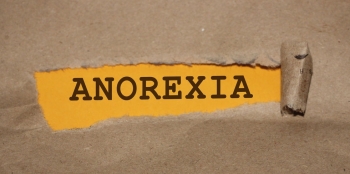
Anorexia Nervosa: Is a psychological disorder characterized by an obsession to be thin and a distorted body image that drives people to be medically underweight.
Criteria Used in Making a Diagnosis of Anorexia Nervosa:
* The individual is not maintaining a body weight within a normal range. Body weight will be 85% or less of what is expected for an individual’s age and height. This can be due to weight loss or alternatively the failure to make expected weight gain during a period of growth. Therefore, someone who has not lost weight but have not gained the weight expected (for his or her age and height) can still have a diagnosis of Anorexia.
* Intense fear of gaining weight despite the fact that they are medically underweight.
* In females the absence of three consecutive menstrual periods when otherwise expected to occur. The other scenario is a teenager who has not yet had her menses and fails to have one due to weight loss or of failure to gain weight as her height increases.
* Disturbance in the way in which one’s body weight, size, or shape is experienced. (E.g. A person reports they feel fat despite the fact that they are considered underweight by medical standards.) This is referred to as distorted body image.
Furthermore, there are two subtypes of Anorexia Nervosa
* Restricting Type: This means that the person does not engage in behaviors such as Binge eating, vomiting, or misuse of Laxatives, diuretics, or enemas.
* Binging/Purging Type: This means that the person is engaging in behaviors such as binge eating, vomiting, and misuse of laxatives, diuretics, and Enemas.
ANOREXIA NERVOSA (PURGING TYPE)
The mortality rate for Anorexics in the (purging type) category is twice as high as those in the restricting category because people within this subtype are at an even greater risk for medical complications. Also, people within this subtype tend to exhibit behavior that is more impulsive. There is a strong association between this subtype and Borderline Personality Disorder. People with behaviors within the binging/purging subtype of Anorexia are more likely to engage in self destructive and impulsive behaviors such as shoplifting, suicidal gestures, substance abuse and self-injury. The “binges” in anorexia are usually different from the binges that will be later being discussed in the sections on Bulimia Nervosa and Binge Eating Disorder. The difference is that the Anorexic person does not usually consume a significant amount of food or calories during these subjective binges. A “true binge” is as least 1000 calories.
Anorexia Nervosa: Age of onset Anorexia primarily begins in adolescence or early adulthood. The mean age for the onset of Anorexia is 17. It most commonly affects girls between the ages of 15 and 19. Anorexia Nervosa usually does not initially present before the age 13 or after the age of 20. With Anorexia Nervosa, most full-blown symptoms develop after the start of puberty. Puberty can be a trigger to an eating disorder partly due to the increase in fat accumulation that occurs in females during this stage of development. This fat accumulation during puberty has an especially negative effect on girls with a poor body image
Anorexia Nervosa can be fatal: Anorexia has a mortality rate estimated to be as high as 20%. The deaths caused by Anorexia are caused by medical complications or from suicide. Anorexia has the highest mortality rate of any psychiatric disorder. If you or a loved one is suffering from anorexia, seek help as soon as possible. .
Frequency of Anorexia Nervosa: The prevalence of Anorexia in the United States is estimated to be between 0.3% and 3.7%.
To speak with a live therapist call at 215-922-5683 Ext. 100 or if you prefer quietly setting yourself up for an appointment, you can self schedule an in-person or virtual therapy appointment. For your convenience we have 5 physical offices and provide virtual therapy services in Florida, Georgia, Pennsylvania, New Jersey, New Mexico and Virginia.
Ocean City Therapy Office
360 West Ave, Floor 1, Ocean City, NJ 08226Mechanicsville Therapy Office
9044 Mann Drive, Mechanicsville Virginia, 23116Society Hill Therapy Office
233 S. 6th Street, C-33, Philadelphia PA 19106Art Museum / Fairmount Therapy Office
2401 Pennsylvania Ave, Suite 1a2, Philadelphia PA 19130Santa Fe Therapy Office, 2204 B Brothers Road, Santa Fe, New Mexico, 87505
Telemedicine: We have therapists who are licensed to work in Florida, Georgia, New Jersey, Virginia New Mexico and Pennsylvania
You deserve the best therapist possible. Our special sauce for helping you achieve your goal, begins with matching you with the right therapist. Check out our GUARANTEE.
Therapy Services Offered:
Individual Counseling and therapy
Couples Counseling and marriage counseling
Teen Therapy and Adolescent Therapy and tweens and child counseling
Family Therapy and multi-generational counseling
Art Therapy and Counseling no art skills needed
ADHD Therapyand ADD, Dyslexia, Autism, Tourettes counseling
Anxiety, Panic, OCD Therapy and worry and fear support
Breaking the cycle of Codependency and being your own person
Overcoming Chronic Illness and Chronic Pain
Depression Therapy and sadness, gloom, and upset support
Grief Therapy and loss, End of A Relationship, rejections, pregnancy loss and therapy
Mindfulness Based Therapy and spirituality based therapy
Sex Therapy and sexual function & dysfunction, sex addiction, sexual orientation and gender identity support
Shame and Blame
Trauma Therapy both emotional and sexual abuse, complex trauma, PTSD counseling
Divorce support
Affairs, Infidelity, Unfaithful, Cheating counseling
Parenting therapy
Personality disorder treatments
Anger Management Therapy
Setting Boundaries and identifying ones own Core Beliefs
Just name some of the Mental Health issues that we work with. Our goal is to help you Change and Achieve Your Dreams






















